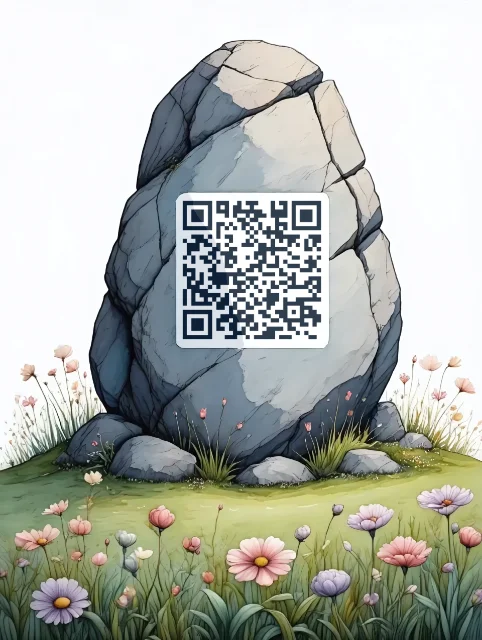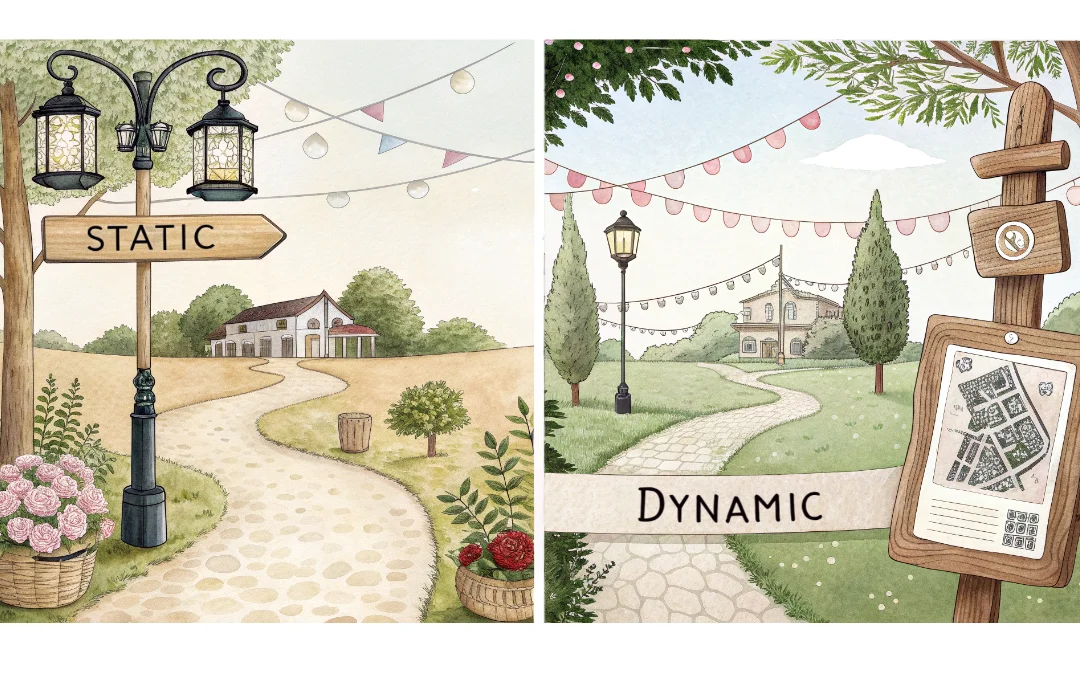Wedding QR Codes 101: Should You Use Static or Dynamic?
Static vs Dynamic QR Codes: Why They Matter and Which You Should Use for Your Wedding
Ah, the modern wedding. It’s got charm, confetti, cake—and yes, QR codes. Once reserved for techy conference badges and restaurant menus, QR codes have taken a glittery leap into the bridal world. From RSVPs and gift registries to seating charts and honeymoon funds, they’re the sleek, scannable secret to keeping your wedding day running smoother than your cousin’s dance moves after two glasses of rosé.
But hold up, lovebirds. Not all QR codes are created equal.
Enter the techy showdown: Static vs. Dynamic QR Codes. You’ve probably heard these terms tossed around like bouquet petals, but what do they really mean? More importantly, which one belongs on your elegantly foiled invitations?
Let’s break it down.
QR codes make the magic happen behind the scenes—make sure you pick the right kind for the show.
What’s the Difference Between Static and Dynamic QR Codes?
Before you pick your perfect code, it helps to know what these terms actually mean. Imagine your QR code is a digital signpost. The question is: is it made of stone or whiteboard? One is permanent—etched with unchangeable instructions. The other is flexible, ready to evolve with your plans.
Choosing the wrong type can lead to more than just a minor hiccup. It could mean reprinting hundreds of invitations, confusing your guests with outdated links, or missing the chance to collect RSVPs altogether. The decision isn’t just about tech—it’s about protecting your peace of mind during one of the most important moments of your life. So let’s break it down and make sure your QR codes are as smart and stress-free as your dream wedding deserves.
Static QR Codes
A static QR code is like carving something in stone. Once you’ve generated it, the data is hardcoded into the pattern itself. This means whatever link or information you entered at the start can’t be changed. What you see is what you get—forever. Even if you make a mistake (like typing “weddingwensite.com” instead of “weddingwebsite.com”), there’s no going back unless you generate a brand-new QR code and reprint everything.
Dynamic QR Codes
Now, dynamic QR codes are the whiteboard version. The code itself contains a short redirect URL that can be updated later to point wherever you want. So, you could start with a simple RSVP form and later change it to a thank-you video or honeymoon slideshow—without reprinting anything.
They’re flexible, editable, and trackable. Some even let you gather analytics like how many people scanned the code and when. These are perfect for the unpredictable nature of wedding planning—because let’s face it, changes happen.
So whether you’re a meticulous planner or a go-with-the-flow bride, understanding these two formats will help you match the right code to the right moment.
Why Use a Static QR Code?
Think of a static QR code as your trusty plus-one for wedding details that won’t budge. If you have information that’s finalized, etched in stone, and not going anywhere—like your wedding website or a digital map to your venue—a static QR code is your best bet.
Because the data is embedded directly into the code, static QR codes are incredibly reliable for fixed uses. They’re also typically free, require no special platform to generate, and are perfect for print. They’re especially useful for brides on a budget or those who are confident there will be no last-minute changes. Just make sure everything is correct before printing—because once it’s locked in, there’s no editing.
Static QR codes work best when you want a simple, effective, and permanent way to share wedding details without the fuss of tracking or updates. You’re either printing new invites or crossing your fingers that Aunt Linda can still figure it out.
Pros of Static QR Codes:
-
- Free to create
- Simple and easy for one-time use
- Great for linking to fixed URLs (like your wedding website)
Cons of Static QR Codes:
-
- Can’t be edited once printed
- No analytics or tracking
- Not ideal if details might change
Static QR codes are great if you’re absolutely sure the info you’re linking to will never ever change. They’re the right choice for things like:
-
- A finalized wedding website
- A digital save-the-date
- A fixed location map
But if you’re even considering switching venues, updating times, or adding that surprise mariachi band to the cocktail hour, keep reading.

Wedding plans may change but your static QR code will remain steadfast like a rock.
Why Use a Dynamic QR Code?
A dynamic QR code is the wedding world’s answer to flexibility. It’s like your best bridesmaid—always ready to help you pivot at a moment’s notice. With dynamic codes, the destination link isn’t set in stone. Instead, you get a short, redirect URL that you can update anytime, even after your invitations, signs, or thank-you cards have already gone to print.
So if you print your invites in January but end up switching your RSVP platform, changing your livestream link, or adding a surprise photo album later, you don’t have to reprint everything. Just log in and update the link behind the code. Voilà! Guests scanning your original QR code are automatically sent to the new destination without a hitch.
Dynamic codes are also the only option if you want access to real-time analytics—so you can track how many people have scanned your code, when they scanned it, and even where they were when they did. It’s ideal for brides who like to stay ahead of every detail.
Pros of Dynamic QR Codes:
-
- Editable after printing
- Provides scan analytics and insights
- Great for evolving or time-sensitive info
- Avoids costly reprints when plans change
Cons of Dynamic QR Codes:
-
- Often requires a paid QR code service
- Slightly more complex to manage
- Needs internet connectivity to update links
In short, if your wedding has even a hint of unpredictability (and let’s be honest, whose doesn’t?), dynamic QR codes are the tech upgrade you didn’t know you needed.
When to Use a Dynamic QR Code:
-
- RSVP tracking that might change platforms
- Digital seating charts
- Live streaming links for virtual guests
- Honeymoon fund pages that update
A dynamic QR code lets you pivot without panic. And that, friends, is worth its weight in peonies.

Adapt like a chameleon: Dynamic QR codes change with your wedding plans, not against them.
Real Wedding Scenarios: What Works Best?
1. The RSVP Portal
Imagine this: You launch your RSVP form through a site that suddenly starts charging fees per guest. Cue panic. With a static QR code, you’re stuck. With a dynamic QR code, you simply update the link. Crisis averted.
Verdict: Dynamic. Always.
2. Ceremony Livestream Link
Grandma can’t make it but wants to watch your vows live. You drop a livestream link into your program. The night before the wedding, the platform changes. If you used a static QR code? Sorry, Grandma. If you used a dynamic one? Update it with a few clicks.
Verdict: Dynamic. Think of the grandmas.
3. Wedding Website
You’re 100% sure it’s done. No changes. The venue is booked, the itinerary is posted, and the registry links are solid.
Verdict: Static works just fine. But if you’re prone to last-minute tweaks, dynamic wins.
Can a Static QR Code Behave Like a Dynamic One?
Here’s a little-known secret: you can mimic the flexibility of a dynamic QR code using a static one—if you’re clever about where it points.
Instead of linking your static QR code directly to your RSVP form, livestream, or registry, point it to a centralized location you control, like a private page on your wedding website or a simple redirect page. This way, you can update the contents or links on that page whenever you need, while your QR code stays the same.
It’s not quite as powerful as a true dynamic QR code (you won’t get scan analytics or advanced redirection features), but it’s a smart workaround if you want to save money or avoid using a paid service.
💡 Pro Tip: Use a platform like WordPress, Wix, or Google Sites to host your own redirect page. Or, if you’re using a wedding planning site, check if it lets you update a central page after it’s published.
Now let’s take a look at how static and dynamic options really compare.
A Quick Comparison
Let’s make this simple:
| Feature | Static QR Code | Dynamic QR Code |
|---|---|---|
| Editable After Printing | ❌ No | ✅ Yes |
| Tracks Scans | ❌ No | ✅ Yes |
| Best For | Fixed URLs | Evolving Info |
| Cost | Free or On Time Fee | Free Trial, Then Monthly Fee |
| Budget-Friendly | ✅ Yes | ❌ No |
| Risk of Mistakes | High | Low |
QR codes make the magic happen behind the scenes—make sure you pick the right kind for the show.
The Wedding Day Details That Make QR Codes Shine
Once you pick your code type, it’s time to make them beautiful. Because let’s be real—a chunky black-and-white square doesn’t exactly scream Pinterest-worthy.
That’s where BridalQRCodes.com comes in.
From watercolor backgrounds that match your theme to personalized codes using your engagement photo, your QR code doesn’t just work—it wows. Choose from designs that blend seamlessly into your signage, invitations, and table cards. They’re not just functional, they’re frame-worthy.
While BridalQRCodes.com doesn’t offer dynamic QR codes, our beautifully crafted static QR codes can link to any destination—whether it’s a page that stays the same or one you update behind the scenes. That means you still get flexibility without sacrificing style. Point your QR code to a central page you control, and you can change the content anytime without touching the printed code.
So if you’re after both elegance and adaptability—and a QR code that complements your color palette—BridalQRCodes.com has your back.
So, Which Should You Choose?
If your wedding communication is fixed, final, and simple, static QR codes will do the trick. But if you’re the type who double checks everything and updates your Google Doc at 2am? Dynamic is your best friend.
Here’s a good rule of thumb:
If it might change, go dynamic. If it’s forever locked in, go static.
Or better yet? Use both. Many modern couples mix and match depending on the use case. RSVP? Dynamic. Menu card? Static. Seating chart? Dynamic. Thank-you card? Static with a little splash of flair.
Final Thoughts: Scannable, Stylish, Stress-Free
Choosing the right type of QR code is like choosing the right cake: not always easy, but totally worth it. When done right, your QR codes will take the guesswork out of wedding day logistics and add a layer of modern convenience your guests will love (and actually use).
So whether you’re team Static or waving the Dynamic flag, make sure your codes are as thoughtful as your table decor.
💍 Ready to make your wedding QR codes both functional and fabulous? Head to BridalQRCodes.com and get started with designs that actually fit your wedding vibe.
Because your big day should be many things—but never boring, never glitchy, and definitely never stuck with a broken QR code.
Happy planning!
